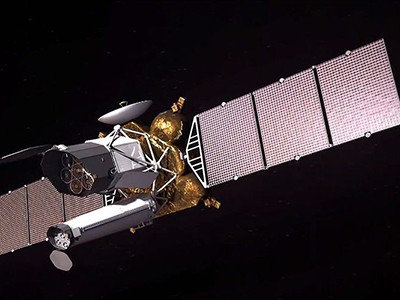Astronomers have reconstructed nearly nine billion years of cosmic evolution by tracing the X-ray glow of distant clusters of galaxies. The analysis supports the standard model of cosmology, according to which the gravitational pull of dark matter — a still-mysterious substance — is the main factor shaping the Universe’s structure.
“We do not see any departures from the standard model of cosmology,” says Esra Bulbul, a senior member of the team and an astrophysicist at the Max Planck Institute for Extraterrestrial Physics (MPE) in Garching, Germany. The results are described1 in a preprint posted online on 14 February.
The galactic clusters were spotted in the most detailed picture ever taken of the sky using X-rays, which was published late last month. This image revealed around 900,000 X-ray sources, from black holes to the relics of supernova explosions.

Space telescope to chart first map of the Universe in high-energy X-rays
The picture was the result of the first six months of operation of eROSITA (Extended Roentgen Survey with an Imaging Telescope Array), one of two X-ray telescopes that were launched into space in July 2019 aboard the Russian spacecraft SRG (Spectrum-Roentgen-Gamma). eROSITA scans the sky as the spacecraft spins, and collects data over wider angles than are possible for most other X-ray observatories. This enables it to slowly sweep the entire sky every six months.
By an unusual arrangement, the eROSITA team is split into two — with a group based in Germany and one based in Russia — and each has exclusive access to eROSITA data from only half of the sky. The mission was originally intended to cover the sky eight times. But Russia’s full-scale invasion of Ukraine in 2022 led the German government to freeze its collaborations, and eROSITA was put on stand-by. By then, it had completed four full sky scans.
The data that Bulbul and her collaborators have used so far were from their half of the sky, collected during the first scan. Even so, the results are already among the most precise cosmological measurements ever made. It is unclear when the Russia-based group will publish its data and analysis.
Evolving Universe
Table of Contents
By looking across vast distances, telescopes such as eROSITA also peer back in time, to see the various stages of cosmic evolution. As the Universe expands, the space between galaxies tends to grow larger, but at the same time, galaxies are pulled towards one another by gravity, including their own and especially that of dark matter. As a result, giant cosmic voids form and expand, and matter increasingly clumps into a web of giant clusters of galaxies.

Cosmic map reveals a not-so-lumpy Universe
Astrophysicist Vittorio Ghirardini at the MPE worked with Bulbul and other collaborators to map the haloes of intergalactic gas surrounding more than 5,000 galaxy clusters in 3D using a combination of eROSITA’s data and an existing map made by the Dark Energy Survey (DES), which uses a telescope in Chile. “Since X-rays are very powerful at detecting haloes, we can be very certain that there is a very big structure there,” Ghirardini says.
The observations span a vast area and time period — approximately 9 billion years. This allowed the researchers to calculate some of the most crucial parameters of cosmic evolution, including ‘lumpiness’ — how much the total mass of matter has concentrated in the cosmic web at any given time. In 2017, similar calculations based on DES data alone seemed to show2 that the web had become lumpy much more slowly than the standard model predicts, but in the latest analysis, that discrepancy has gone away. (Results made public last year from a separate cosmology experiment also indicated harmony with the standard model3.)
Neutrino boundary
Furthermore, the galactic-cluster data enabled the team to tease out the role of neutrinos in shaping the cosmic web. Copious amounts of these elementary particles were produced in the Big Bang, and their low masses and reluctance to interact with other particles mean that they act like dark matter, forming haloes around galaxies. From this information, the astrophysicists calculated that neutrinos could have masses of no more than 0.22 electronvolts (an electron has a mass of around 500,000 eV). “These are the tightest measurements of the neutrino masses available,” Bulbul says; lab measurements on Earth have so far established4 a larger upper limit of 0.8 eV.
Even if eROSITA’s observations never resume, the team’s work is not over yet. “We have a lot more data we are working on,” says Bulbul. The team will eventually be able to map gas halos that are smaller, fainter or more distant than the ones in the current catalogue — and to increase the precision of the measurements.
The same applies to the other types of X-ray source mapped by eROSITA, such as quasars, the intensely bright supermassive black holes at the centres of many galaxies. Studies on this trove of information have only just begun, says eROSITA spokesperson Mara Salvato, an astrophysicist at the MPE. “By the end of the mission, we expect to catalogue three million objects.”
